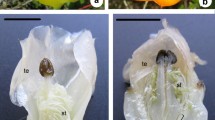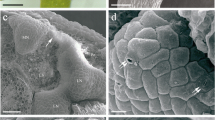Abstract
Tocoyena formosa has a persistent floral nectary that continues producing nectar throughout flower and fruit development. This plant also presents an intriguing non-anthetic nectary derived from early-developing floral buds with premature abscised corolla. In this study, we characterize the structure, morphological changes, and functioning of T. formosa floral nectary at different developmental stages. We subdivided the nectary into four categories based on the floral and fruit development stage at which nectar production started: (i) non-anthetic nectary; (ii) anthetic nectary, which follows the regular floral development; (iii) pericarpial nectary, derived from pollinated flowers following fruit development; and (iv) post-anthetic nectary that results from non-pollinated flowers after anthesis. The nectary has a uniseriate epidermis with stomata, nectariferous parenchyma, and vascular bundles, with a predominating phloem at the periphery. The non-anthetic nectary presents immature tissues that release the exudate. The nectary progressively becomes more rigid as the flower and fruit develop. The main nectary changes during flower and fruit development comprised the thickening of the cuticle and epidermal cell walls, formation of cuticular epithelium, and an increase in the abundance of calcium oxalate crystals and phenolic cells near the vascular bundles. Projections of the outer periclinal walls toward the cuticle in the post-anthetic nectary suggest nectar reabsorption. The anatomical changes of the nectary allow it to function for an extended period throughout floral and fruit development. Hence, T. formosa nectary is a bivalent secretory structure that plays a crucial role in the reproductive and defensive interactions of this plant species.






Similar content being viewed by others
References
Amorim FW, Oliveira PE (2006) Estrutura sexual e ecologia reprodutiva de Amaioua guianensis Aubl. (Rubiaceae), uma espécie dióica de formações florestais de cerrado. Braz J Bot 29:353–362. https://doi.org/10.1590/S0100-84042006000300003
Amorim FW, Marino S, Sanz-Veiga PA et al (2022) Short flowers for long tongues: functional specialization in a nocturnal pollination network of an asclepiad in long-tongued hawkmoths. Biotropica 54:729–738. https://doi.org/10.1111/btp.13090
Baerheim-Svendsen A, Verpoorte R (1983) Chromatography of alkaloids: thin-layer chromatography. Elsevier Science Limited.
Baker HG, Baker I (1973) Amino-acids in nectar and their evolutionary significance. Nature 241:543–545. https://doi.org/10.1038/241543b0
Bernardello G (2007) A systematic survey of floral nectaries. In: Nicolson SW, Nepi M, Pacini E (eds) Nectaries and nectar. Springer, Netherlands, Dordrecht, pp 19–128
Brown WH (1938) The bearing of nectaries on the phylogeny of flowering plants. Proc Am Philosoph Soc 79:549–595. http://www.jstor.org/stable/984940
Calvin CL (1970) Anatomy of the aerial epidermis of the mistletoe, Phoradendron flavescens. Bot Gaz 131:62–74. https://doi.org/10.1086/336513
Chatt EC, Mahalim S-N, Mohd-Fadzil N-A et al (2021) Nectar biosynthesis is conserved among floral and extrafloral nectaries. Plant Physiol 185:1595–1616. https://doi.org/10.1093/plphys/kiab018
Chomicki G, Staedler YM, Schönenberger J, Renner SS (2016) Partner choice through concealed floral sugar rewards evolved with the specialization of ant–plant mutualisms. New Phytol 211:1358–1370. https://doi.org/10.1111/nph.13990
da Cunha AR, Martins D (2009) Classificação climática para os municípios de Botucatu e São Manuel, SP. Irriga 14:1–11. https://doi.org/10.15809/irriga.2009v14n1p1-11
David R, JP Carde (1964) Coloration différentielle des inclusions lipidiques et terpéniques des pseudophylles du Pin maritime au moyen du réactif nadi. C R Acad Sci Paris 258:1338–1340
De la Barrera E, Nobel PS (2004) Nectar: properties, floral aspects, and speculations on origin. Trends Plant Sci 9:65–69. https://doi.org/10.1016/j.tplants.2003.12.003
Del-Claro K, Guillermo-Ferreira R, Zardini H et al (2013) Ants visiting the post-floral secretions of pericarpial nectaries in Palicourea rigida (Rubiaceae) provide protection against leaf herbivores but not against seed parasites. Sociobiol 60:217–221. https://doi.org/10.13102/sociobiology.v60i3.217-221
Durkee LT, Gaal DJ, Reisner WH (1981) The floral and extra-floral nectaries of Passiflora. I. The Floral Nectary. Am J of Bot 68:453–462. https://doi.org/10.1002/j.1537-2197.1981.tb07789.x
Fahn A (1979) Secretory tissues in plants. Academic Press, London, UK
Fahn A (2000) Structure and function of secretory cells. In: Advances in botanical research. Academic Press, pp 37–75. https://doi.org/10.1016/S0065-2296(00)31006-0
Falcão JCF, Dáttilo W, Izzo TJ (2014) Temporal variation in extrafloral nectar secretion in different ontogenic stages of the fruits of Alibertia verrucosa S. Moore (Rubiaceae) in a Neotropical savanna. J Plant Interact 9:137–142. https://doi.org/10.1080/17429145.2013.782513
Florentin MN, Cabaña Fader A, Gonzalez AM (2016) Morpho-anatomical and morphometric studies of the floral structures of the distylous Oldenlandia salzmannii (Rubiaceae). Acta Bot Bras 30:585–601. https://doi.org/10.1590/0102-33062016abb0247
Galen C (1999) Why do flowers vary? Bioscience 49:631–640. https://doi.org/10.2307/1313439
Galetto L (1995) Nectary structure and nectar characteristics in some Bignoniaceae. Pl Syst Evol 196:99–121. https://doi.org/10.1007/BF00985338
Galetto L (1998) Estructura floral y composición química del néctar en tres especies de Rubiaceae. Kutziana 26:83–98
Galetto L, Bernardello LM (1992) Extrafloral nectaries that attract ants in Bromeliaceae: structure and nectar composition. Can J Bot 70:1101–1106. https://doi.org/10.1139/b92-136
Gottsberger G, Silberbauer-Gottsberger I (2006) Life in the cerrado a South American tropical seasonal ecosystem - Pollination and seed dispersal, Reta, Ulm
Guimarães E, Tunes P, Almeida Junior LD et al (2018) Nectar replaced by volatile secretion: a potential new role for nectarless flowers in a bee-pollinated plant species. Front Plant Sci 9:1243. https://doi.org/10.3389/fpls.2018.01243
Heil M (2011) Nectar: generation, regulation and ecological functions. Trends Plant Sci 16:191–200. https://doi.org/10.1016/j.tplants.2011.01.003
Johansen DA (1940) Plant microtechnique. New York and London, McGraw-Hill Publ. Co., Ltd., Aldwych House, London, W.C.2
Judkevich MD, Salas RM, Gonzalez AM (2022) Anatomy of the floral nectaries of selected species of Gardenieae (Rubiaceae). Rodriguésia 73:e01732020. https://doi.org/10.1590/2175-7860202273072
Koeppen W (1948) Climatologia: con un estudio de los climas de la tierra
Koptur S (1992) Plants with extrafloral nectaries and ants in everglades habitats. Fla Entomol 75:38–50. https://doi.org/10.2307/3495479
Koptur S (2005) Nectar as fuel for plant protectors. In: Wäckers EL, van Rijn PCJ, Bruin J (eds) Plant-provided food for carnivorous insects: a protective mutualism and its applications. Cambridge University Press, Cambridge, UK, pp 75–108
Korth KL, Doege SJ, Park S-H et al (2006) Medicago truncatula mutants demonstrate the role of plant calcium oxalate crystals as an effective defense against chewing insects. Plant Physiol 141:188–195. https://doi.org/10.1104/pp.106.076737
Larcher W (1980) Physiological plant ecology, 2nd edn. Springer-Verlag, Berlin, Germany
Mace ME, Howell CR (1974) Histochemistry and identification of condensed tannin precursors in roots of cotton seedlings. Can J Bot 52:2423–2426. https://doi.org/10.1139/b74-314
Machado SR, Carmello-Guerreiro SM, Teixeira SP, Rodrigues TM (2022) Células e tecidos secretores. In: Appezzato-da-Gloria B, Carmello-Guerreiro SM. Anatomia Vegetal, 4nd edition. UFV, Viçosa, Brazil pp 178–208
Mazia D, Brewer PA, Alfert M (1953) The cytochemical staining and measurement of protein with mercuric bromphenol blue. Biol Bull 104:57–67. https://doi.org/10.2307/1538691
McDowell EM, Trump BF (1976) Histologic fixatives suitable for diagnostic light and electron microscopy. Arch Pathol Lab Med 100:405–414
Mesquita-Neto JN, Paiva EAS, Galetto L, Schlindwein C (2020) Nectar secretion of floral buds of Tococa guianensis mediates interactions with generalist ants that reduce florivory. Frontiers Plant Sci 11:627. https://doi.org/10.3389/fpls.2020.00627
Nepi M (2007) Nectary structure and ultrastructure. In: Nicolson SW, Nepi M, Pacini E (eds) Nectaries and nectar. Springer, Netherlands, Dordrecht, pp 129–166
Nepi M, Ciampolini F, Pacini E (1996) Development and ultrastructure of Cucurbita pepo nectaries of male flowers. Ann Bot 78:95–104. https://doi.org/10.1006/anbo.1996.0100
O’Brien TP, Feder N, McCully ME (1964) Polychromatic staining of plant cell walls by toluidine blue O. Protoplasma 59:368–373. https://doi.org/10.1007/BF01248568
Oliveira PE, Gibbs PE, Barbosa AA (2004) Moth pollination of woody species in the cerrados of Central Brazil: a case of so much owed to so few? Plant Syst Evol 245:41–54. https://doi.org/10.1007/s00606-003-0120-0
Pacini E, Nepi M, Vesprini JL (2003) Nectar biodiversity: a short review. Plant Syst Evol 238:7–21. https://doi.org/10.1007/s00606-002-0277-y
Paiva EAS (2012) Anatomy, ultrastructure, and secretory activity of the floral nectaries in Swietenia macrophylla (Meliaceae). Am J Bot 99:1910–1917. https://doi.org/10.3732/ajb.1200122
Paiva EAS (2017) How does the nectar of stomata-free nectaries cross the cuticle? Acta Bot Bras 31:525–530. https://doi.org/10.1590/0102-33062016abb0444
Paiva EAS (2019) Are calcium oxalate crystals a dynamic calcium store in plants? New Phytol 223:1707–1711. https://doi.org/10.1111/nph.15912
Paiva EAS, Machado SR (2005) Role of intermediary cells in Peltodon radicans (Lamiaceae) in the transfer of calcium and formation of calcium oxalate crystals. Braz Arch Biol Technol 48:147–153. https://doi.org/10.1590/S1516-89132005000100019
Paiva EAS, Ballego-Campos I, Gibernau M (2021) True nectar or stigmatic secretion? Structural evidence elucidates an old controversy regarding nectaries in Anthurium. Am J Bot 108:37–50. https://doi.org/10.1002/ajb2.1595
Queiroga da DS, Moura RF (2017) Positive relation between abundance of pericarpial nectaries and ant richness in Tocoyena formosa (Rubiaceae). Sociobiol 64:423–429. https://doi.org/10.13102/sociobiology.v64i4.2107
Ramalingam K, Ravindranath MH (1970) Histochemical significance of green metachromasia to toluidine blue. Histochemie 24:322–327. https://doi.org/10.1007/BF00278217
Ratter JA, Bridgewater S, Ribeiro JF (2003) Analysis of the floristic composition of the Brazilian cerrado vegetation III: comparison of the woody vegetation of 376 areas. Edinb J Bot 60:57–109. https://doi.org/10.1017/S0960428603000064
Ren G, Healy RA, Klyne AM et al (2007) Transient starch metabolism in ornamental tobacco floral nectaries regulates nectar composition and release. Plant Sci 173:277–290. https://doi.org/10.1016/j.plantsci.2007.05.008
Santos JC, Del-Claro K (2001) Interação entre formigas, herbívoros e nectários extraflorais em Tocoyena formosa (Cham. & Schlechtd.) K. Schum. (Rubiaceae) na vegetação do cerrado. Rev Bras Zoociê 3:1.
Sanz-Veiga PA, Jorge LR, Benitez-Vieyra S, Amorim FW (2017) Pericarpial nectary-visiting ants do not provide fruit protection against pre-dispersal seed predators regardless of ant species composition and resource availability. PLoS ONE 12:e0188445. https://doi.org/10.1371/journal.pone.0188445
Sanz-Veiga PA, Polizello DS, Silva DP et al (2021) The specialist of a specialist: the natural history of the predispersal seed predator weevil Hemicolpus abdominalis (Coleoptera: Curculionidae). Ecol Entomol 46:1006–1018. https://doi.org/10.1111/een.13064
Silberbauer-Gottsberger I (1972) Anthese und Bestäubung der Rubiaceen Tocoyena brasiliensis und T. formosa aus dem Cerrado Brasiliens. Österr Bot Z 120:1–13. https://doi.org/10.1007/BF01373254
Stefani V, Alves VN, Lange D (2019) Induced indirect defence in a spider–plant system mediated by pericarpial nectaries. Austral Ecol 44:1005–1012. https://doi.org/10.1111/aec.12766
Stpiczyńska M, Nepi M, Zych M (2012) Secretion and composition of nectar and the structure of perigonal nectaries in Fritillaria meleagris L. (Liliaceae). Plant Syst Evol 298:997–1013. https://doi.org/10.1007/s00606-012-0609-5
Subramanian RB, Arumugasamy K, Inamdar JA (1990) Studies in the secretory glands of Hiptage sericea (Malpighiaceae). Nord J Bot 10:57–62. https://doi.org/10.1111/j.1756-1051.1990.tb01753.x
Thomas V, Dave Y (1992) Structure and biology of nectaries in Tabebuia serratifolia Nichols (Bignoniaceae). Bot J Linn Soc 109:395–400. https://doi.org/10.1111/j.1095-8339.1992.tb00281.x
Tölke EEAD, Galetto L, Machado SR et al (2015) Stages of development of the floral secretory disk in Tapirira guianensis Aubl. (Anacardiaceae), a dioecious species. Bot J Linn Soc 179:533–544. https://doi.org/10.1111/boj.12340
Vassilyev AE (2010) On the mechanisms of nectar secretion: revisited. Ann Bot 105:349–354. https://doi.org/10.1093/aob/mcp302
Vesprini JL, Nepi M, Pacini E (1999) Nectary structure, nectar secretion patterns and nectar composition in two Helleborus species. Plant Biol (stuttg) 1:560–568. https://doi.org/10.1055/s-2007-978553
Vogel S (1974) Ölblumen und ölsammelnde Bienen. In: Tropische und Subtropische Pflanzenwelt. Steiner Verlag pp 283–547.
Acknowledgements
This study was carried out as part of the JVI master’s thesis at the Programa de Pós-graduação em Ciências Biológicas (Botânica), IBB, UNESP. We thank J. V. Alcantara, E. Dal Farra, L. Hachuy Filho, C. S. Ballarin, P. Sanz Veiga, and Heloíza Cassola for assistance during field work and sampling.
Funding
This study was supported by the “Coordenação de Aperfeiçoamento de Pessoal de Nível Superior”-Brazil (CAPES, Finance code 001). This work received financial support from São Paulo Research Foundation (FAPESP, grant number 2021/13392–0) to SRM and Conselho Nacional de Desenvolvimento Científico e Tecnológico (CNPq) (FWA, grant numbers 484469/2013–4 and 308559/2022–3; SRM, grant 308982/2020–7).
Author information
Authors and Affiliations
Contributions
FWA, JVI, YC, and SRM conceived and designed the research. JVI and FWA carried out field work and sampling. JVI and YC carried out the laboratory work. YC, JVI, and SRM conducted the data analysis and wrote the original draft. FWA, JVI, YC, and SRM reviewed and edited.
Corresponding authors
Ethics declarations
Competing interests
The authors declare no competing interests.
Additional information
Communicated by: Łukasz Stępień
Publisher's Note
Springer Nature remains neutral with regard to jurisdictional claims in published maps and institutional affiliations.
Rights and permissions
Springer Nature or its licensor (e.g. a society or other partner) holds exclusive rights to this article under a publishing agreement with the author(s) or other rightsholder(s); author self-archiving of the accepted manuscript version of this article is solely governed by the terms of such publishing agreement and applicable law.
About this article
Cite this article
Izquierdo, J.V., Canaveze, Y., Machado, S.R. et al. Anatomical, histochemical, and developmental approaches reveal the long-term functioning of the floral nectary in Tocoyena formosa (Rubiaceae). Sci Nat 111, 25 (2024). https://doi.org/10.1007/s00114-024-01909-5
Received:
Revised:
Accepted:
Published:
DOI: https://doi.org/10.1007/s00114-024-01909-5




